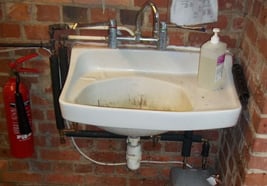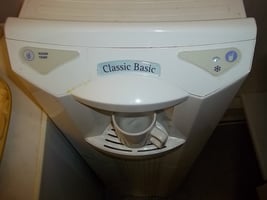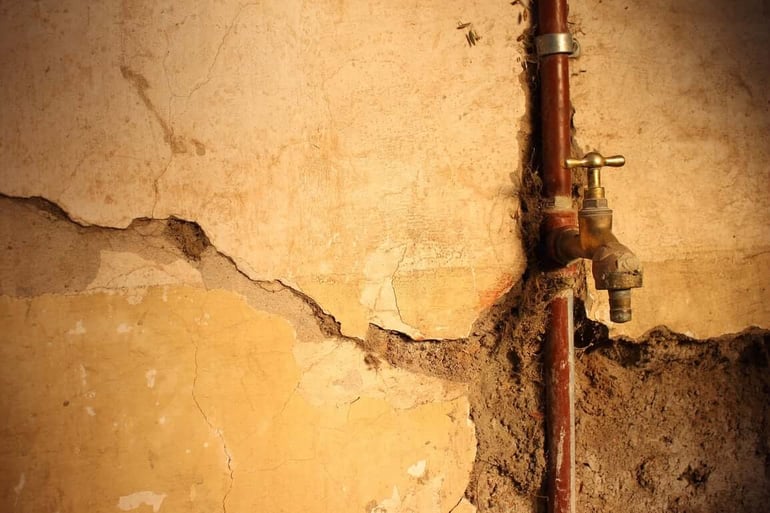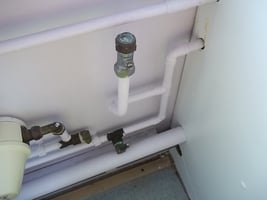There is a requirement for all building managers to ensure the safety of the public and employees so far as reasonably practicable. This requirement is set out in the Health and Safety at Work Act 1974, The Management of Health and Safety Regulations 1999, Control of Substances Hazardous to Health (COSHH) 2002, the HSE’s ACoP L8: “Legionnaires’ disease, the control of legionella bacteria in water systems”, the associated HSG274 Technical Guidance Part 2: “The control of legionella bacteria in hot and cold water systems” 2014 and the Department of Health’s HTM 04-01 “Safe Water in Healthcare Premises” Parts A, B and C, 2016.
What are Dead Legs and Blind Ends? 
The Health Technical Memorandum 04-01 Part B defines a dead leg as a length of pipework leading to a fitting through which water only passes infrequently when there is a draw-off from a fitting, creating potential stagnation.
HTM 04-01 Part A Section 12.5 sets out guidance that pipe branches should be designed to avoid stagnation. As far as practical, the maximum length of any pipework between a terminal device and a recirculating system or a cold-water distribution mains should be kept to a minimum; generally, the complete length of the spur should not exceed 3 metres. The length is measured from the centre line of the circulation pipework to the point of discharge along the centre line of the pipework. These pipes should be insulated.
A blind end is defined in HSG274 Part 2 as a length of pipework that is closed at one end through which no water passes. For example, where a wash hand basin in a room has been removed, allowing the room to be used as a store or office, the basin supply pipework may be capped off, leaving lengths of pipework containing stagnant water and creating blind ends on the hot and cold water services.
Both blind ends and dead legs increase the risk of biofilm formation and create the right conditions for Legionella, Pseudomonas aeruginosa, and other waterborne pathogens to proliferate. These waterborne pathogens may then leach back into the parent supply and contaminate the system, thereby increasing the health risk to anyone using the water system.
Biofilm is defined as a complex layer of microorganisms that have attached and grown on a surface. This form of growth provides a niche environment for a wide range of microorganisms to interact, where the secretion of exopolysaccharides by bacteria forms an extracellular matrix that protects both bacteria and other unicellular organisms, such as amoebae and flagellates. The internal surfaces of pipework, water tanks, water outlets, shower heads, and hoses are a few examples where biofilm can form.
How can they be managed?
Where water is allowed to stagnate, there is a risk of contamination. The key elements of managing the pipework distribution system are to keep the system clean, keep the water flowing, and keep the hot water hot and cold water cold. In addition, the following points should also be considered;
- Ensure the Legionella risk assessment, schematic drawings, and as-fitted drawings are up to date and reviewed.
BS8580-1: 2019 Section 10.1 gives guidance as to when a risk assessment needs to be reviewed;
The original risk assessment should be formally reassessed when there are significant changes to ensure that it remains valid, for example, when there are:
a) changes to the water system or its use;
b) changes to the use of the building or part of the building in which the system is installed;
c) changes to the availability of information about risks or control measures;
d) indications that control measures are no longer effective;
e) any of the factors in Clause 4;
f) new construction works or system modifications planned; or
g) changes to the key personnel, contractors, and service providers.
Where a reassessment has not been triggered by the above, a policy of planned reassessment should be implemented. - In existing buildings where the use of a room containing a water outlet is changed, requiring no water outlet, a reporting system must be in place to alert the relevant department, e.g. estates department, to ensure all pipework to the outlet is removed, ensuring that any “T”s are removed, back to the distribution loop. In Healthcare facilities, the Water Safety Group (WSG) should monitor this regularly.
 If the outlet is to be retained and is low use, then an appropriate Legionella flushing regime should be put in place. HSG 274 Part 2, table 2.1 sets out guidance on the management of little-used outlets with a weekly flushing regime or as indicated by the Legionella risk assessment. In Healthcare premises, HTM0401 describes an even more frequent flushing frequency, depending on the circumstamnces. It is essential to note that once a flushing regime has been implemented, it is sustained, and accurate water safety records of flushing are maintained.
If the outlet is to be retained and is low use, then an appropriate Legionella flushing regime should be put in place. HSG 274 Part 2, table 2.1 sets out guidance on the management of little-used outlets with a weekly flushing regime or as indicated by the Legionella risk assessment. In Healthcare premises, HTM0401 describes an even more frequent flushing frequency, depending on the circumstamnces. It is essential to note that once a flushing regime has been implemented, it is sustained, and accurate water safety records of flushing are maintained. - Where new buildings, extensions, or refurbishments are planned, there is a risk that the new building, extension, or refurbished area may be left empty between the time the contractors have moved out and the users of the building have moved in. During this period, the area could become one large dead end.
It is essential to have a robust flushing regime and microbiological sampling regime in place until the building is returned to normal occupancy and use. Typically, the FM service provider or Estates team is the incumbent interim party responsible for ensuring that the flushing regime is carried out. This period, where the building space may be unoccupied after project completion, should be managed in line with the protocol agreed upon by the Project Water Safety Group. - Where new builds or extensions are planned, it is essential to involve the Water Safety Group and the estate's operational teams at the earliest stage of design to ensure the proposed water distribution system and any associated primary heating sources are going to be fit for purpose, including the minimisation of the risk of dead legs and blind ends. The creation and implementation of a Project Water Safety Group (which feeds into the main WSG) is vital to ensure that all aspects of water safety are considered, risk assessed, reviewed, ratified, and agreed upon before any project works are undertaken. Project governance is key.
 In design, there needs to be certainty that on completion of the pipework, the water outlets, particularly stand-alone water coolers, dishwashers, washing machines, and specialised equipment requiring a water supply, are going to be fitted and used. If there is doubt regarding the equipment, consideration should be given to excluding the water service supply from the main contract and, if required, installing the water supply post-contract.
In design, there needs to be certainty that on completion of the pipework, the water outlets, particularly stand-alone water coolers, dishwashers, washing machines, and specialised equipment requiring a water supply, are going to be fitted and used. If there is doubt regarding the equipment, consideration should be given to excluding the water service supply from the main contract and, if required, installing the water supply post-contract.
- It is essential that the water commissioning records for any new building, extension or refurbishment are comprehensive and show the flow rates and temperature profiles for all outlets, water storage tanks, and hot water generators. As fitted drawings, water system schematics, flushing records for when the building was unoccupied, commissioning data (including disinfection certificates), and Legionella risk assessments must all be available at the building handover from the main contractor.
Feel free to reach out if you have any questions about the issues mentioned above, Project Water Safety Groups, or if you would like to consult with one of our experts on water hygiene.
Editors Note: The information provided in this blog is correct at the date of original publication - June 2019 (Revised July 2025).
Image by (El Caminante) from Pixabay
© Water Hygiene Centre 2025










